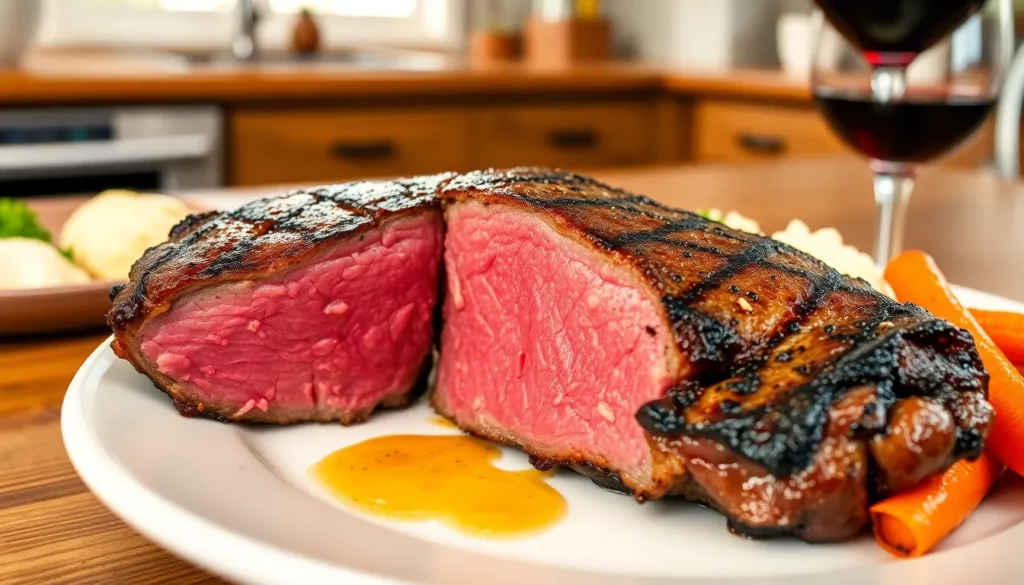In the preparation of a steak, arguments of doneness can become as hot as the grill itself. It is a common occurrence in my family, especially between my sister and me. I have cooked the meat and I think it is medium rare rather than what she claims is raw and bloody. Does this also happen to you?

People have their preferences when it comes to steaks and this may lead to some table discussions. Whether you love a good piece of meat and spare ribs or you just want to outdo a friend over the steak with no war, this guide will help you learn and master the levels of doneness in a steak and the writ will recommend closing the arguments for good.
The Hard Facts About Steak Levels of Doneness
Before you learn how to make the best steak, you first need to learn what the degrees of doneness refer to. Finally, rated from the least cooked to the most cooked, it is presented as follows:
1. A steak that is considered rare in cooking can only be enjoyed by those that are edge loving to the almost primitive level. The thick piece of meat measuring approximately 25 millimeters in thickness has a seared crust, a cool red center, and an ideal internal temperature of 120°F to 125°F. The core is soft and wet, and contains the most moisture. Not for the weak stomach: it does look raw for some people’s taste.
2. Many meaty fantasies come true right here. A medium-rare steak that has warm bright red in the centre and 130°F to 135°F temperatures is a steak that could not be missed for those seeking a smooth cut that is neither dry nor too juicy. The outer surface has an appealing brown crust while the surface is moist and still juicy. Ideally, this is the best steak for everyone including me, but this is where my sister and I begin our fight over a properly cooked steak.
3. For a well-cooked steak, the internal temperature of the meat certainly goes up to 140 degrees Fahrenheit to 145 degrees Fahrenheit, but most well cooked steaks have a colored flesh that is still warm in the center. It is more solid than medium rare but there is still the juiciness factor. This is usually the compromise for those who want some color inside but do not want reddish interior.
4. A steak cooked to 150°F to 155°F is predominantly brown with just a slight tinge of pink in the center. For those who like their steak not so juicy and are on the firmer side of the meat scale, medium-well comes at a high price. It is getting truly well-done yet still has a hint of the tenderness.
5. A well-done steak looks brown from the outside to the center without any hint of pink inside. The temperature for this type of meat rises to 160°F and above. One cannot expect the juicy and tender cut of meat in this case. Some want their beef steaks prepared this way as they feel it is a more classic and stronger taste that well done steaks are generally prepared however when completely cooked through.
Ingredients
- 2 steaks (ribeye, sirloin, or filet mignon, your choice)
- 1 tablespoon olive oil
- Salt and pepper to taste
- 2 tablespoons unsalted butter
- 3 cloves garlic, smashed
- Fresh thyme or rosemary sprigs (optional)
Instructions
- Approach each of the steaks with care by using a paper towel to absorb some of their moisture. Sprinkle salt and pepper on both of the sides abundantly. For thirty minutes, do not refrigerate the steaks but allow them to remain at room temperature. This is to enhance the cooking since the cooking will be more even towards the cuts of meat.
- Using a non-stick skillet or a cast-iron pan, place them on medium-high flame until necessary heat is attained. Pour 1 tablespoon of legaciedo olive oil and heat up until rippling but not smoking.
- Now that the pan is extremely hot, you can put the steaks inside. Do not touch the meat searing the other side for 3-4 minutes until a brown crust forms. Turn over and sear the other side for another 3 – 4 minutes.
- For the final cooking minute, turn down the heat to a medium setting. Insert butter, smashed garlic, and thyme or rosemary into the pan. Tip the pan and with the help of a spoon, drizzle melted butter over the steak for enhanced taste.
- If temperatures as high as 130°F to 135°F are enough for medium rare, temperature of the thin meat thermometer is inserted into the thickest lunar portion more about proper use. For other doness levels:
–Rare: 120°F to and 125°F
–Medium: 140°F to 145°F
–Medium well: 150°F to and 155°F
–Well done: 160°F internal temperature and above. - After they are done cooking, take the steaks out of the pan and set them onto a chopping board. Allow 5-10 minutes before slicing. This is to allow the juices to re-distribute, preventing a dry steak after cutting.
- Makes lateral cuts to the steak and pair it with your preferred – sides.
How to Achieve the Desire of Perfect Steak Doneness.
Let us accept the fact that steak doneness is a matter of preference but getting it right every single time can be achieved after some conditioning and of course some tools. Here are a few tips that will facilitate the desired steak doneness.

Use a Meat Thermometer
The easiest and most accurate way to check the doneness of your steak is by using a meat thermometer. Insert the thermometer into the thickest part of the steak for an accurate reading. Remember, the steak will continue to cook after you remove it from the heat, so aim to take it off 5°F to 10°F before your desired internal temperature.
The Touch Test
If you find yourself without a thermometer, you can resort to the touch test. With your thumb and middle finger encourage that your palm is confined evenly around its base: The soft skin on the base of the index finger which is located below the thumb feels like a medium rare steak. Hence, if the steak is well enough to feel the palm, it is quite well done. It’s a handy trick when you don’t have a thermometer available!
Allow the Steak to Rest
One of the most important (but often neglected) steps is allowing your steak to rest after cooking. Once the steak has been taken off the heat source, it is best to let it stay for 5 to 10 minutes. This helps in even distribution of the juices which in turn ensures a well enhanced flavor and juiciness to the steak. Do not fret – this will lead your steak to rise in temperature slightly even though it is no longer in the heat source.
Wherein Lies The Difference- Medium-Rare Or Raw
So, is that steak medium-rare or he undercooked it? The main distinction here is this: An ideal medium-rare steak has a warm center and the texture is soft yet firm. If there is a red warm center, more likely your steak is undercooked and may require a few more minutes back on the fire.
Frequently Asked Questions (FAQs)
1. How can I tell if my steak is done without a meat thermometer?
If you don’t have a meat thermometer, try using the touch test. Lightly press the palm of your hand while touching your thumb and fingers together to compare the firmness of your steak:
Thumb + Index finger = Rare
Thumb + Middle finger = Medium-rare
Thumb + Ring finger = Medium
Thumb + Pinky finger = Well-done
2. How long should I let my steak rest after cooking?
You should let your steak rest for about 5-10 minutes after removing it from the heat. This allows the juices to redistribute throughout the steak, making it more tender and juicy when sliced.
3. What’s the best type of steak for grilling?
Cuts like ribeye, sirloin, and filet mignon are ideal for grilling because they have good marbling and tenderness. Ribeye is rich and juicy, sirloin is leaner, and filet mignon is the most tender. Choose based on your preference for flavor and texture.
